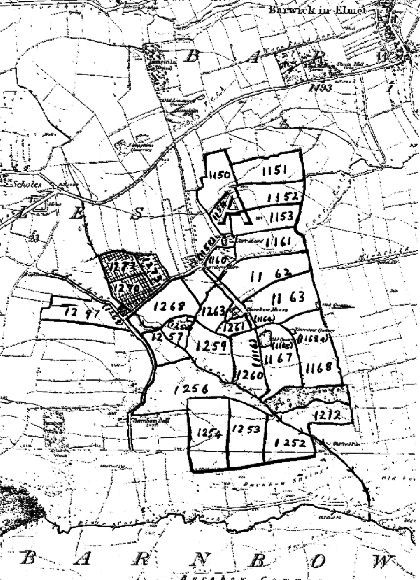| THE FARM OF EDWARD FURNISS OF BARNBOW |
| Plan No. |
Name of property |
Cultivation |
Acreage |
| |
|
|
ac. |
r. |
p. |
| 1150 |
Great Bents and Top Garth |
Arable |
8. | 0. | 5 |
| 1151 |
Little Bents and Wall Close |
Arable |
9. |
2. |
14 |
| 1152 |
South Near and Little Wall Close |
Arable |
9. |
0. |
2 |
| 1153 |
North Great Field |
Grass |
7. |
3. |
10 |
| 1154 |
Croft |
Grass |
4. |
1. |
37 |
| 1158 |
Road |
- |
0. |
1. |
14 |
| 1159 |
Farmhouse (Carr Head), Barn, Stables, Cowhouses, Cart Shed, Yards and Orchard. |
- |
0. |
2. |
25 |
| 1160 |
Grass Holme |
Grass |
4. |
1. |
3 |
| 1161 |
South Great Field |
Grass |
8. |
2. |
23 |
| 1162 |
North Slack Burn & part of Marl Pit Field |
Arable |
14. |
0. |
0 |
| 1163 |
South Slack Burn & part of Marl Pit Field |
Arable |
12. |
3. |
21 |
| 1164 |
Occupation Lane |
- |
1. |
0. |
8 |
| 1165 |
Old Quarry |
- |
1. |
0. |
11 |
| 1166 |
Lane |
- |
0. |
1. |
12 |
| 1167 |
Quarry Field and Brown Close |
Arable |
11. |
0. |
15 |
| 1168 |
Limekiln Field and Clayhole Close |
Arable |
15. |
3. |
11 |
| 1168a |
Old Quarry |
- |
0. |
0. |
15 |
| 212 |
Wood Close, Shoulder of Mutton and part of Broadbent Close |
Grass |
12. |
3. |
36 |
| 1252 |
Crabb Flat and part of House Close |
Arable |
10. |
0. |
33 |
| 1253 |
Cow Close and part of House Close |
Arable |
11. |
3. |
12 |
| 1254 |
Low Pasture and Low Field |
Grass |
11. |
1. |
0 |
| 1256 |
Long Close, Two Acres and Low Field |
Grass |
34. |
3. |
23 |
| 1257 |
Barnbow Carr |
Grass |
8. |
2. |
37 |
| 1258 |
Willow Garth |
Willows |
0. |
0. |
14 |
| 1259 |
Ash Hills |
Arable |
10. |
2. |
4 |
| 1260 |
Well Field and Little Ash Hill |
Arable |
9. |
1. |
5 |
| 1261 |
Croft |
Grass |
2. |
3. |
4 |
| 1262 |
Farmhouse, barn, stables,
cowhouse, cart shed, yards and garden |
- |
0. |
2. |
28 |
| 1263 |
Ashhole Close |
Arable |
6. |
3. |
8 |
| 1268 |
Carr Close |
Arable |
10. |
3. |
29 |
| 1297 |
Top Pasture and Carr Close |
Arable |
10. |
0. |
2 |
| |
Total |
£249.2.11d. |
|
|
|
| |
Total Estimated Rental |
£273.7s.6d. |
|
|
|
| |
Rateable Value |
£248.9s.6d. |
|
|
|

